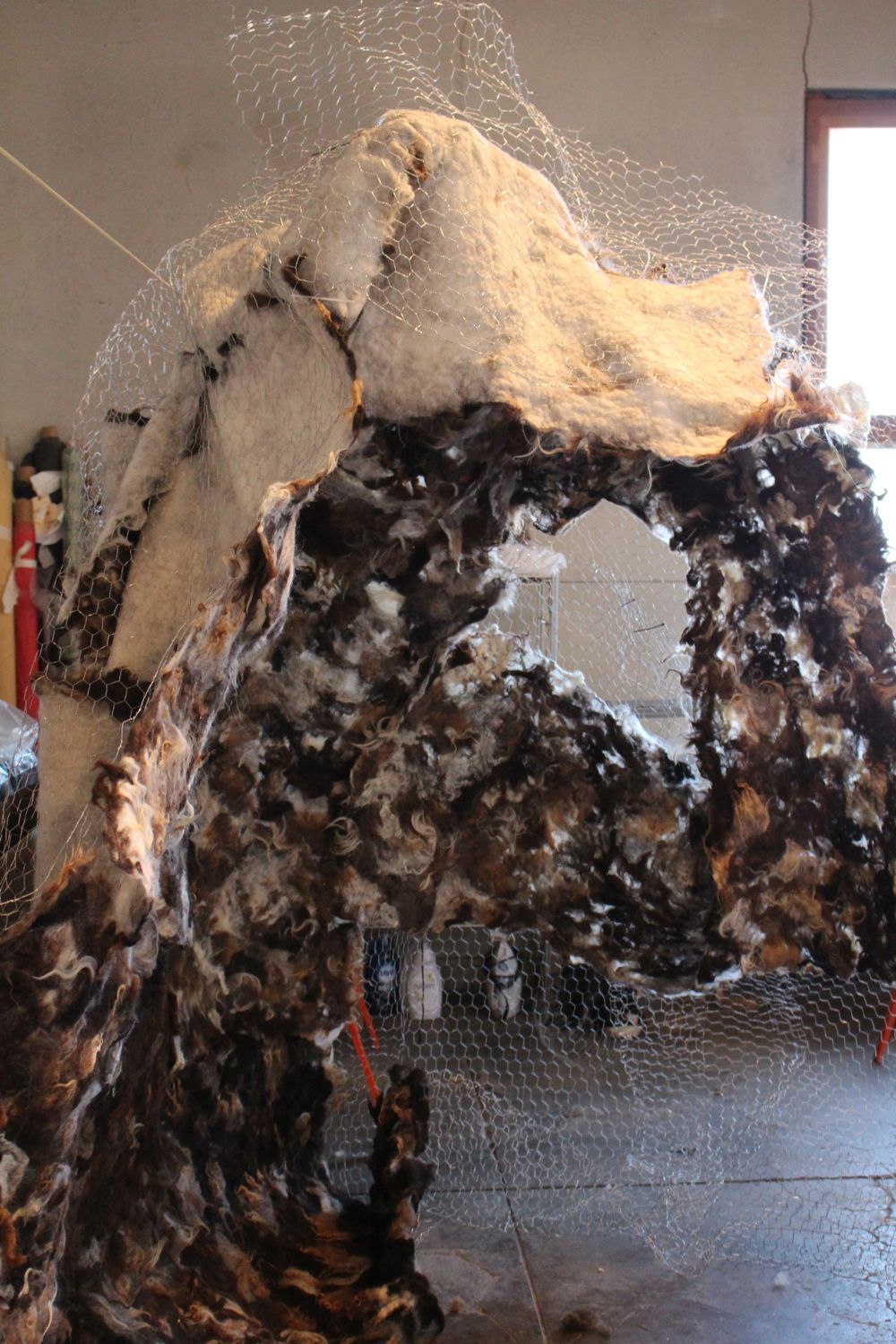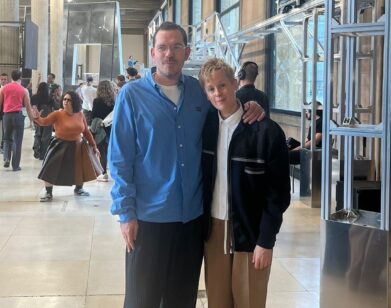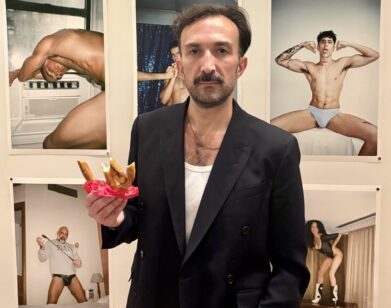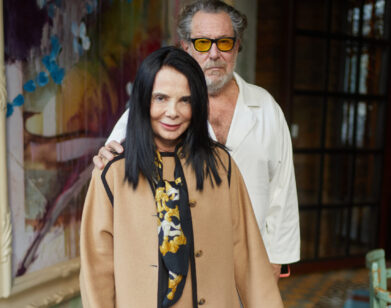Jeanine Oleson’s Ear of the Other
Jeanine Oleson is an artist whose interdisciplinary practice incorporates multiple media, including film/video, installation, performance, photography, and text. Frequently employing wordplay, neologism, and visual orthographics in both title and content (e.g., (M)end Time, 2012, OMG (Oh, Magog!), 2011, I Ran Contraband Spirituality, 2010), Oleson’s oeuvre engages in political, societal, spiritual, and psychological spaces using a prolific mix of wit and woe. Themes of apocalyptic anxiety, ecological destruction, and alternative modes of activism are explored in performance mash-ups, often responding to collective consultation, interviews, and workshops.
Due to its multiplicity of form, Oleson’s work resists conventional curatorial efforts. (For example: The Shore is Still in the Sea (2012) includes a series of photographs, sculptures, photographic sculptures, archival inkjet prints, cyanotypes, text, a performance, and an artist’s book; no one object is to be read in isolation). The New Museum has afforded Oleson ample space to investigate the topic of voice over the course of a four-month residency. The superabundance of public programming in conjunction with the show is a reflection of both the artist’s commitment to collaborative research and the museum’s educational initiative “R&D Seasons.”
We met Oleson the day after her birthday at 235 Bowery, a warehouse currently undergoing transformation into NEW INC., a museum-led incubator. After being greeted by PaweÅ? Althamer‘s assistants, who share the same floor with Oleson, we toured the works in progress before heading to the roof to discuss the upcoming exhibition, experimental opera, and, of course, voice.
RACHEL EGAN: I wanted to talk with you about your residency with the New Museum, as well as the exhibition component and the ongoing public programming.
JEANINE OLESON: Johanna Burton, the [Keith Haring Director and] Curator of Education [and Public Engagement], had initially asked me to participate. She came in about a year ago to the New Museum and wanted to rethink what the education department was doing within the context of museum itself. I am the artist-in-residence partnering with Research & Development Seasons: “VOICE” programming. The inaugural season examined “Archives.” I was invited not only to have a show but also to think about everything that is important to making of a show and the research that goes along with art production.
From a research perspective, I have been working with ESP, the New Museum’s Experimental Study Program [pairing teens with artists-in-residence to collaborate on project-based research and discussion related to VOICE], which has been great. Really engaging kids. We have also initiated a seminar series, on the topic of voice. It’s a weekly, peer-led reading group of about 15 participants selected through an application process. It’s been great as well. We will be producing a public symposium in mid-May for that.
I also organized and moderated a panel discussion last week on the topic of voice. It was a fairly eclectic group of people whose work I admire and find extremely exciting. Johanna discussed her own research on affect theory and audience engagement outside of the context of her role within the institution. Gregg Bordowitz explored the multiplicity of voices, followed by Maura Mills, an Assistant Professor of Media, Culture, and Communication at NYU and prominent disabilities and technology scholar. She talked about voice modulation, electronic signals, and essentialist notions of voice. The last speaker was Steve Cosson, who is the Artistic Director of The Civilians.
EGAN: I’m actually a huge fan of Cosson’s work with The Civilians and their investigations with interview, verbatim text, and document-theatricality. The Great Immensity reminds me a bit of your piece The Shore is Still in the Sea.
OLESON: Yes! He discussed the idea of interview and from that, the process into theater and then into musical theater. That was very interesting. Overall, it was a range of different people speaking different languages concerning their expertise.
EGAN: What else have you been working on theatrically?
OLESON: The first program I did for R&D Seasons: VOICE was The Rocky Horror Opera Show. That involved a crazy amount of costume production. It came from this idea that I’ve had and been working on for some time concerning the relationship between audiences and cultural producers, particularly the 19th-century conception of connoisseurship and those who care deeply about work for no apparent professional gain or motivation. So much of what we do these days is dictated by our professionalized identity within late capitalism. I then thought about what that might all mean as an opera fanatic.
I had talked to Cori Ellison about a project where I was interviewing opera fans and together we cooked up the idea for this recital with an empowered audience. The title “The Rocky Horror Opera Show” came from a revelation that allowing for radical viewer participation was quite similar to Rocky Horror, but in our case for opera devotees.
EGAN: It’s such an interesting intersection, between Rocky Horror fans who are part of their own cult and classical opera followers that have a similar level of fanaticism.
OLESON: [laughs] Actually, this was a problem! A few people came who were actually Rocky Horror fans. One girl showed up dressed as Janet and ended up putting her boa on one of the singers, which was copacetic since the public had been encouraged to do whatever they were moved to do.
I had been exploring the idea of what might happen if the rules of engagement and participation are changed for an audience. The show was a very “traditional” concert—beloved arias performed by a quartet of singers accompanied by a pianist and conventionally clothed by opera standards. It all looked very normal, in a sense, however the audience was dressed in costumes that were loosely based on characters described within the arias being sung.
EGAN: Has The Rocky Horror Opera Show informed your experimental opera premiering in June?
OLESON: In some ways, yes, but they’re ultimately different pieces. The upcoming opera is more in the vein of my performance work in the past-breaking apart language, thinking about the wretchedness of the world and how to put it through bodies, what it means to look at that wretchedness again with the attention and care of an audience.
EGAN: Since the opera will be premiering separately in June, what will be included in the gallery space for the opening of Hear, Here in April?
OLESON: The gallery is set up to evoke the idea of a theater when you first enter. It has a two-channel video piece cut from a live taping I made of The Rocky Horror Opera Show where the audience and performers are somewhat separated, save for people going back and forth dependent upon their interactions. Then there are sculptures/sets and objects/props in the show that will be used in the piece I am writing for June. A lot of these things are paradoxical, like the “eye light” prop that projects light instead of gathering rays, or the set piece of a reversible mountain/cave. There’s a functional horn object based on the shape of an ear that I worked with a brass instrument repairperson to build. It has a section coupled into it where I made 3-D prints of vocal tracks for different vowels. It’s entirely playable, albeit oddly tuned with weird fingerings because all of the track lengths are different.
EGAN: I understand that there will also be a publication in conjunction with your residency.
OLESON: It’s a takeaway, basically—a poster. There is an accordion print in the show as well, which I think of as the mapping for many ideas in Hear, Here. There’s an image of touching someone’s throat as they make noise, a picture of a vocal chord—[laughs] which looks like a vagina, of course—and a person coming out of a cave. All revolve around the idea of voice, the response to the external, the process of the internal becoming the external, and what that all has to do with care, with politics, and with agency. The operatic. More of this is tied to the activation of the objects used in the performance when being looked at in the gallery space. It implicates the viewers into thinking about potential uses of the works—sculpture, object, prop, and/or set —while leaving open other possibilities. I’ve always done this, I feel like I’ve just gone gangbusters this time around.
JEANINE OLESON’S EXHIBITION “HEAR, HERE” IS ON VIEW AT THE NEW MUSEUM FROM STARTING TODAY, THROUGH JULY 6. HER OPERA PREMIERS AT THE NEW MUSEUM’S THEATER ON JUNE 13 AT 7 PM.







